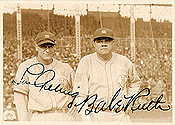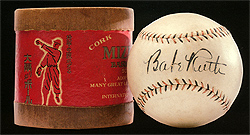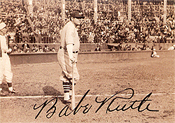The Collection of Mitsuhiko Fujita

 The late 1920s to early 1930s welcomed the Golden Age of American baseball, led by the Yankees 1-2 punch of Babe Ruth and Lou Gehrig. Their achievements inspired Japanese baseball's own Golden Age, which peaked with the visit of the Ruth and Gehrig-led U.S. All-Stars in 1934. While earlier US teams (beginning as early at 1888) and later teams (post WWII) traveled to Japan to face the best competition the Japanese could offer, the 1934 tour had the most dramatic effect on the popularity of baseball in Japan. The selection of the All-Nippon team which would face the 1934 American greats led to the formation of the Japanese professional league two years later, ending Japan's 60-year period of exclusively amateur baseball.
The late 1920s to early 1930s welcomed the Golden Age of American baseball, led by the Yankees 1-2 punch of Babe Ruth and Lou Gehrig. Their achievements inspired Japanese baseball's own Golden Age, which peaked with the visit of the Ruth and Gehrig-led U.S. All-Stars in 1934. While earlier US teams (beginning as early at 1888) and later teams (post WWII) traveled to Japan to face the best competition the Japanese could offer, the 1934 tour had the most dramatic effect on the popularity of baseball in Japan. The selection of the All-Nippon team which would face the 1934 American greats led to the formation of the Japanese professional league two years later, ending Japan's 60-year period of exclusively amateur baseball.
 The Mitsuhiko Fujita Collection represents the finest and most extensive collection of autographed baseballs and photos ever offered which document
The Mitsuhiko Fujita Collection represents the finest and most extensive collection of autographed baseballs and photos ever offered which document
 this Golden Age. In addition to the exceptional and unparalleled group of items related to the 1934 tour, are signed balls and photographs from the 1931 Major League All-Star tour, the Ty Cobb Goodwill tour of 1928, the Philadelphia Giants tour of 1932, various Nisei team tours, and tours by the University of Michigan, Yale University, University of California, University of Illinois, and University of Chicago baseball teams. The exceptional nature of this collection of autographs and photos of the American baseball greats is readily apparent. However, this collection also represents the single greatest assemblage of autographs of pre-war Japanese and American Nisei baseball legends ever publicly offered. Many of the autographs of the Japanese Hall of Earners are from early in their careers, with some representing the earliest known autographs of these early stars.
this Golden Age. In addition to the exceptional and unparalleled group of items related to the 1934 tour, are signed balls and photographs from the 1931 Major League All-Star tour, the Ty Cobb Goodwill tour of 1928, the Philadelphia Giants tour of 1932, various Nisei team tours, and tours by the University of Michigan, Yale University, University of California, University of Illinois, and University of Chicago baseball teams. The exceptional nature of this collection of autographs and photos of the American baseball greats is readily apparent. However, this collection also represents the single greatest assemblage of autographs of pre-war Japanese and American Nisei baseball legends ever publicly offered. Many of the autographs of the Japanese Hall of Earners are from early in their careers, with some representing the earliest known autographs of these early stars.
Born into the distinguished family of his grandfather Baron Denzaburo Fujita in 1911, Mitsuhiko Fujita grew up watching and playing baseball in Kobe Japan. Through his grandfather's connections, young Mitsuhiko gained access to many areas in which the general public was not allowed. Always taking his camera on the ball field, Mitsuhiko took many photographs of Japanese baseball players and American Tour Team players. Having the images developed the same day Mitsuhiko was able to immediately return to the ballparks to have the prints signed.
 According to stories told from his son, to improve his own game Mitsuhiko visited players in their hotel in Osaka and had lessons from future Hall of Famers. Babe Ruth gave Mitsuhiko batting tips; Earl Whitehill taught him pitching techniques. Throughout his whole life Mitsuhiko was very bright, polite and a bit eccentric. He loved baseball to the very end of his life, cherishing these unique items that he collected, which still present an unparalleled window into the most glorious eras of both Japanese and American Baseball in Japan.
According to stories told from his son, to improve his own game Mitsuhiko visited players in their hotel in Osaka and had lessons from future Hall of Famers. Babe Ruth gave Mitsuhiko batting tips; Earl Whitehill taught him pitching techniques. Throughout his whole life Mitsuhiko was very bright, polite and a bit eccentric. He loved baseball to the very end of his life, cherishing these unique items that he collected, which still present an unparalleled window into the most glorious eras of both Japanese and American Baseball in Japan.